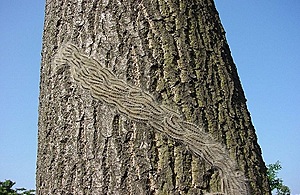
Everyone is reminded, particularly those in London and surrounding counties, to report sightings of OPM caterpillars, and to not touch them under any circumstances.
Forestry Commission are acting to tackle the oak tree pest, oak processionary moth in parts of London and South East England.
Oak processionary moth was first identified in London in 2006 and has since spread to some surrounding counties.
The caterpillars and their nests contain hairs which can cause itchy rashes, eye and throat irritations, so a Government programme is in place to limit their spread. They can also occasionally cause breathing difficulties in people and pets, so should not be touched under any circumstances.
People with infested trees in the control zone have been advised that work needs to take place over the next two months to help stop the spread of this pest. Contractors spraying affected trees on behalf of the Forestry Commission will carry out work safely, adhering to social distancing guidelines.
Craig Harrison, the Forestry Commission's South-East England Director, said:
Green spaces with trees are proving particularly valuable for visitors of woodlands, who are exercising whilst practicing social distancing this spring.
Controlling OPM will help protect oak tree health and ensure continued enjoyment of parks and woodland by reducing the impact of OPM caterpillars to human health.
Everyone is reminded, particularly those in London and surrounding counties, to report sightings of OPM caterpillars, which could be damaging oak trees in their area.
Any sightings should be reported to the Forestry Commission via TreeAlert. Alternatively, people can email






